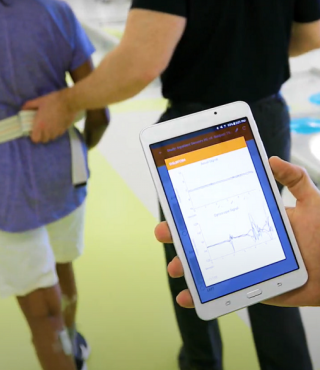Purpose
The PHQ-4 items are drawn from the Generalized Anxiety Disorder-7 (GAD-7) and Patient Health Questionnaire-8 (PHQ-8). The PHQ-4 briefly and accurately measures depression and anxiety.


Center for Smart Use of Technologies to Assess Real World Outcomes (C-STAR)

May 9–10
Live and Online
Offered by Academy, Shirley Ryan AbilityLab
The PHQ-4 items are drawn from the Generalized Anxiety Disorder-7 (GAD-7) and Patient Health Questionnaire-8 (PHQ-8). The PHQ-4 briefly and accurately measures depression and anxiety.
1
1-2 minutes
18 - 94
yearsAdam Steuer, MS, OTR/L, CLT
None
Pre-operative Surgical Patients: (Kerper et al., 2014)
The authors advise against using the PHQ-2 and GAD-2 as exclusive measures of depression and anxiety in preoperative surgical patients. They also suggest lowering the cut-off point from 6 to 4 in order to yield the best trade-off between sensitivity and specificity.
College Students: (Khubchandani, Brey, Kotecki, Kleinfelder, & Anderson, 2016)
Use of the PHQ-4 without options for confirming diagnosis can result in a number of false positives indicative of higher levels of distress and dysphoria but not clinical depression. The PHQ-4 has high sensitivity, but diagnostic tests are required for high specificity.
General Population: (Löwe et al., 2010)
Elevated anxiety or depression scores require a thoughtful evaluation by the treating physician or psychologist before a diagnostic or therapeutic decision can be made.
Breast Cancer: (Weihs, Wiley, Crespi, Krull, & Stanton, 2017)
The PHQ-4 warrants further study for determining if the measure is an efficient and accurate screener of depression immediately after breast cancer diagnosis.
Breast Cancer Survivors: (Weihs, Wiley, Crespi, Krull, & Stanton, 2017; n = 410 women; mean age = 56 (12) years; 75% some college; 67% married; 52% employed; stages 1, 2, 3, and 4: 44%, 39%, 11%, and 5%, respectively)
Development sub sample has moderate agreement (K = .45)
Validation subsample has moderate agreement where models and thresholds derived from the development process were applied to the holdout validation sample to evaluate performance (K = .50)
Predictive Validity
Breast Cancer Survivors: (Weihs et al., 2017)
|
|
Accuracy |
Sensitivity |
Specificity |
PPV |
NPV |
|
Development Subsample of PHQ-4 |
0.72 |
0.65 |
0.80 |
0.77 |
0.69 |
|
Validation Subsample of PHQ-4 |
0.75 |
0.74 |
0.76 |
0.69 |
0.81 |
Chronic Migraine: (Bagley et al., 2012; n = 8726; 83.5% female; 86.1% white/Caucasian; headache pain severity mild, moderate, and severe: 1.3%, 19.8%, and 78.9%, respectively
Excellent: Cronbach's Alpha = 0.87 to 0.96
Chronic Migraine: (Bagley et al., 2012)
Adequate correlation with Migraine Quality of Life Questionnaire (r = 0.30 to -0.47)
Fibromyalgia: (Hauser et al., 2012; n = 1647; 94.8% female; 77.4% living with partner)
Adequate correlation with Somatic Severity Score (r = 0.56)
Adequate correlation with Fibromyalgia Survey Questionnaire (r = 0.48)
Primary Care: (Kroenke, Spitzer, Williams, & Löwe, 2009; n = 2149; aged 18-94; mean age = 47.2 (15.4) years; 66% female; 81% non-Hispanic white; 8% African-American; 8% Hispanic; 64% married; 7% had less than a high school education; 31% had a high school degree or equivalent; 62% had some college)
An elevated score on the PHQ-4 of 6 or greater is not diagnostic but is, instead, an indicator for further inquiry to establish the presence or absence of a clinical disorder warranting treatment
Pre-operative Surgical Patients: (Kerper et al., 2014; n = 2852; mean age = 47; 52% female; 62.6% living with a partner; 42.9% college experience)
PHQ-4 scores greater than or equal to 4 are significant for detecting psychological distress
General Population: (Löwe et al., 2010; n = 5036; 53.6% female; mean age = 48.4 (18) years; 59.9% living with a partner)
PHQ-4 scores of 6 (percentile 95.7%) or greater are “yellow flags” indicating depression or anxiety disorder
PHQ-4 scores of 9 (percentile 99.1) or greater are “red flags” indicating depression or anxiety disorder
General Population: (Löwe et al., 2010)
Author provided the percentile rank for PHQ-4 scores for individuals aged 14-92. For example, a PHQ-4 score of 3 for any man or woman of any age indicates a percentile rank of 75.5 in the total population.
|
PHQ-4 Score |
N = 5003, % rank |
|
|
0 |
19.6 |
|
|
1 |
47.6 |
|
|
2 |
63.1 |
|
|
3 |
75.5 |
|
|
4 |
85.9 |
|
|
5 |
92.7 |
|
|
6 |
95.7 |
|
|
7 |
97.5 |
|
|
8 |
98.5 |
|
|
9 |
99.1 |
|
|
10 |
99.4 |
|
|
11 |
99.7 |
|
|
12 |
99.9 |
|
Mortality Prediction: (Michal et al., 2015; n = 191 patients from N = 1384 died; deceased and alive men were 67% and 64%, respectively; age of deceased and alive men were 74.9 and 69.9 years old, respectively)
|
|
PHQ-4 score categories |
|
|
|
|
|
|
Total Sample (n = 1350) |
Score 0-1 (n = 688) |
Score 2-3 (n = 315) |
Score 4-5 (n = 203) |
Score 6-12 (n = 144) |
|
Death Rate |
13.8% (n = 186) |
11.0% (n = 76) |
13.0% (n = 41) |
17.2% (n = 35) |
23.6% (n = 34) |
College Students: (Khubchandani et al., 2016; n = 934; mean age = 20.32 (2.72) years; 63% female; 80% Whites; 95% enrolled full time; 60% enrolled as 1st or 2nd year undergraduates; 9.2% had diagnosis of depression in the past year; 18.6% had a diagnosis of anxiety in the past year)
Very good agreement for anxiety screener (K = 0.81)
Good agreement for depression screener (K = 0.70)
Primary Care: (Kroenke et al., 2009)
Pre-operative Surgical Patients: (Kerper et al., 2014)
College Students: (Khubchandani et al., 2016)
General Population: (Löwe et al., 2010)
Pre-operative Surgical Patients: (Kerper et al. 2014)
Excellent predictive validity (AUC = 0.88)
|
|
Sensitivity |
Specificity |
PPV |
NPV |
|
PHQ-4 Criterion Standard: BSI-GSI |
0.515 |
0.945 |
0.615 |
0.920 |
Lowered cutoff point of less than or equal to 4, sensitivity was 80.5%, specificity was 80.2% for detecting clinically significant psychological distress according to the Global Severity Index (GSI)
College Students: (Khubchandani et al., 2016)
Excellent predictive validity for anxiety (AUC = 0.835)
Good predictive validity for depression (AUC = 0.787)
Primary Care: (Kroenke et al., 2009)
Excellent correlation with the categories of Medical Outcomes Study Short Form General Health Survey (SF-20):
Excellent mental health (r = 0.80)
Adequate social functioning (r = 0.52)
Adequate general health perceptions (r = 0.48)
Poor role functioning (r = 0.37)
Poor bodily pain (r = 0.36)
Poor physical functioning (r = 0.36)
Pre-operative Surgical Patients: (Kerper et al. 2014)
Good discriminant validity indicated by:
Poor age (r = 0.05)
Poor gender (r = 0.13)
Poor partnership status (r = -0.10)
Poor education (r = -0.04)
Poor physical health (r = 0.03)
Adequate to good convergent validity has moderate to strong correlations with:
Good Brief System Inventory (BSI) depression scale (r = 0.68)
Good BSI anxiety scale (r = 0.63)
Adequate BSI phobic anxiety scale (r = 0.46)
Good BSI interpersonal sensitivity scale (r = 0.56)
Good Global Severity Index (r = 0.69)
Good PHG single item of subjective psychosocial impairment (r = 0.70)
College Students: (Khubchandani et al., 2016)
Principal components analysis (PCA) using varimax rotated component-matrix for 4 screening items (2 items each for PHQ-2 and GAD-2) indicated that 83% variance was explained by the 2 components. 2 anxiety screening items had the highest loading on component 1 and the 2 depression screening items had highest loading on component 2.
|
4-Item Depression & Anxiety Scale |
Component Loadings |
|
|
|
Component 1 |
Component 2 |
|
Feeling nervous, anxious, or on edge |
0.903 |
0.205 |
|
Not being able to stop or control worrying |
0.861 |
0.313 |
|
Feeling down, depressed, or hopeless |
0.378 |
0.795 |
|
Little interest or pleasure in doing things |
0.169 |
0.908 |
General Population: (Löwe et al. 2010)
Adequate correlation with the Rosenberg Self-Esteem Scale (r = -0.49 to -0.40)
Adequate correlation with the Questionnaire on Life Satisfaction (r = 0.39 to -0.39)
Adequate correlation with the Resilience Scale (r = 0.35 to -0.28)
Bagley, C. L., Rendas‐Baum, R., Maglinte, G. A., Yang, M., Varon, S. F., Lee, J., & Kosinski, M. (2012). Validating the Migraine‐Specific Quality of Life Questionnaire v2.1 in episodic and chronic migraine. Headache: The Journal of Head and Face Pain, 52(3), 409-421. https://doi.org/10.1111/j.1526-4610.2011.01997.x
Häuser, W., Jung, E., Erbslöh-Möller, B., Gesmann, M., Kühn-Becker, H., Petermann, F., ... & Wolfe, F. (2012). Validation of the Fibromyalgia Survey Questionnaire within a cross-sectional survey. PLoS One, 7(5), e37504. https://doi.org/10.1371/journal.pone.0037504
Kerper, L., Spies, C., Tillinger, J., Wegscheider, K., Salz, A. L., Weiss-Gerlach, E., ... & Krampe, H. (2014). Screening for depression, anxiety and general psychological distress in preoperative surgical patients: A psychometric analysis of the Patient Health Questionnaire 4 (PHQ-4). Clinical Health Promotion, 4(1), 5-14.
Khubchandani, J., Brey, R., Kotecki, J., Kleinfelder, J., & Anderson, J. (2016). The psychometric properties of PHQ-4 depression and anxiety screening scale among college students. Archives of Psychiatric Nursing, 30(4), 457-462. https://doi.org/10.1016/j.apnu.2016.01.014
Kroenke, K., Spitzer, R. L., Williams, J. B., & Löwe, B. (2009). An ultra-brief screening scale for anxiety and depression: The PHQ-4. Psychosomatics, 50(6), 613-621. https://doi.org/10.1176/appi.psy.50.6.613
Löwe, B., Wahl, I., Rose, M., Spitzer, C., Glaesmer, H., Wingenfeld, K., ... & Brähler, E. (2010). A 4-item measure of depression and anxiety: Validation and standardization of the Patient Health Questionnaire-4 (PHQ-4) in the general population. Journal of Affective Disorders, 122(1), 86-95. https://doi.org/10.1016/j.jad.2009.06.019
Michal, M., Prochaska, J. H., Keller, K., Göbel, S., Coldewey, M., Ullmann, A., ... & Beutel, M. E. (2015). Symptoms of depression and anxiety predict mortality in patients undergoing oral anticoagulation: Results from the thrombEVAL study program. International Journal of Cardiology, 187, 614-619. https://doi.org/10.1016/j.ijcard.2015.03.374
Weihs, K. L., Wiley, J. F., Crespi, C. M., Krull, J. L., & Stanton, A. L. (2017). Predicting Future Major Depression and Persistent Depressive Symptoms: Development of a Prognostic Screener and PHQ4 cutoffs in Breast Cancer Patients. Psycho‐Oncology. https://doi.org/10.1002/pon.4472
We have reviewed more than 500 instruments for use with a number of diagnoses including stroke, spinal cord injury and traumatic brain injury among several others.